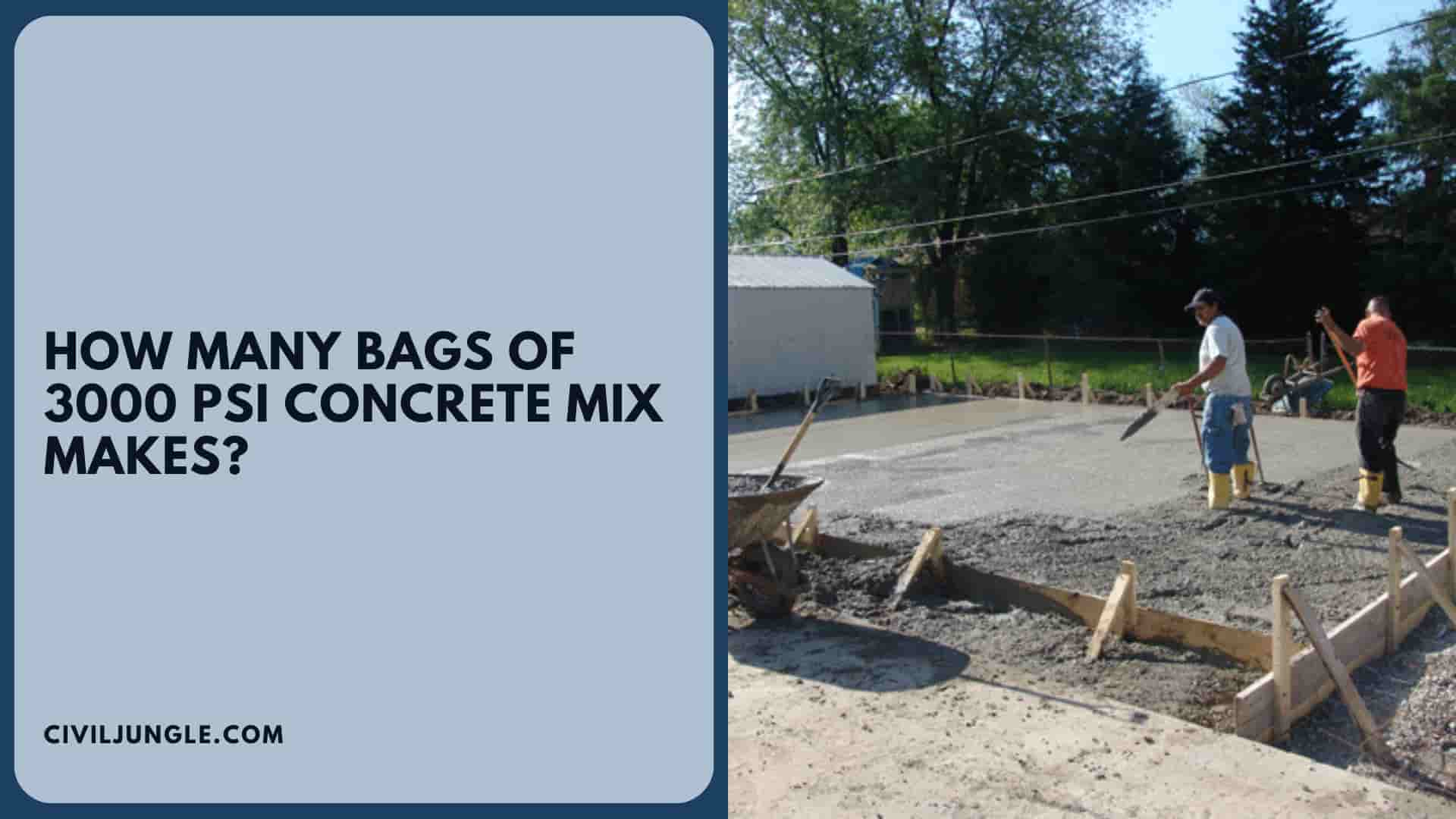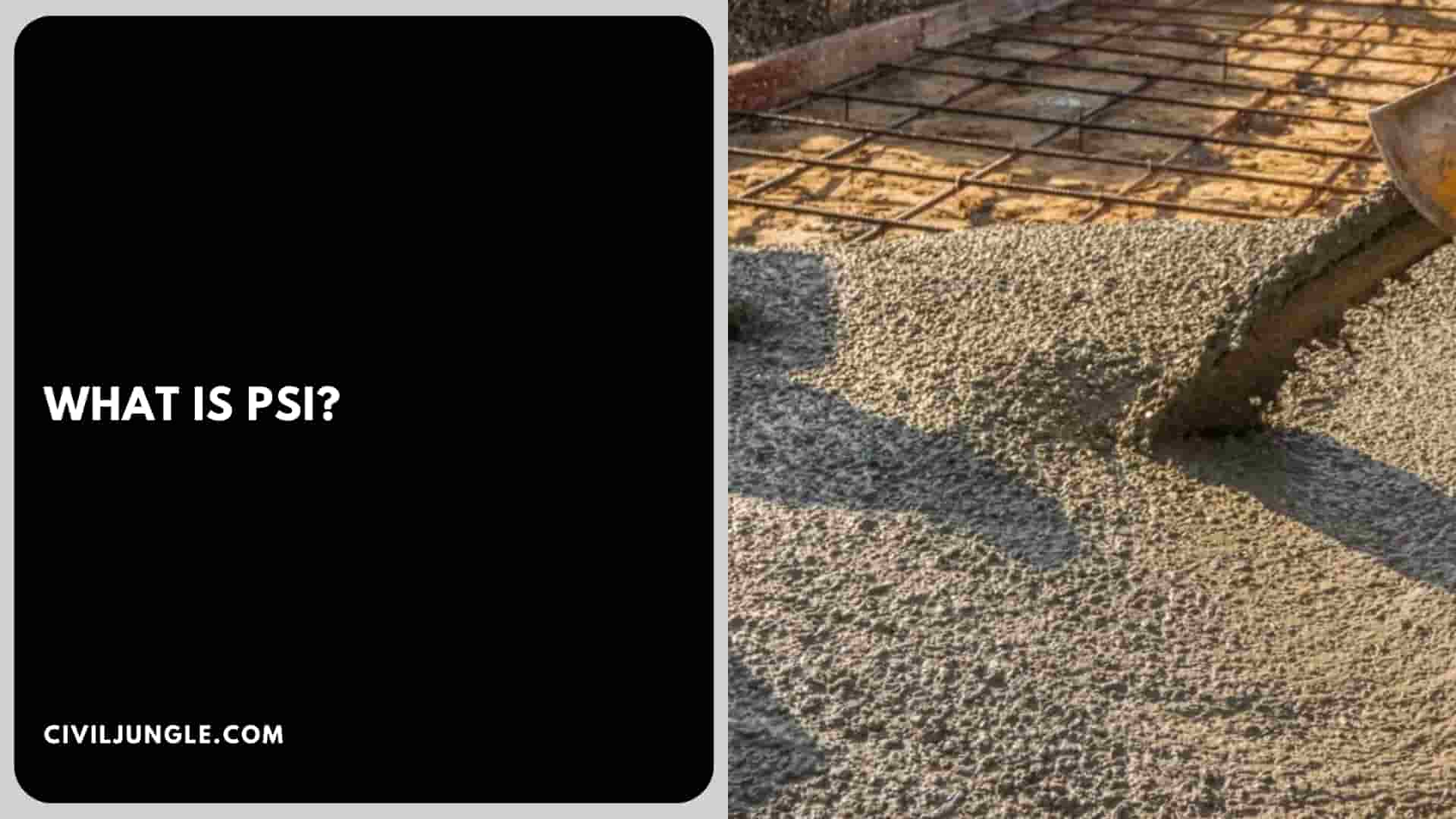How Many Bags of 3000 PSI Concrete Mix Makes?
Important Point
The residential workhorse of concrete 3000 PSI is used for driveways, patios, and sidewalks. Its durability will help ease the freeze-thaw cycle of harsh winters.
The more cement is added to the mix, the higher its PSI rating after it hardens. For example, a 3000 psi concrete mix contains five bags of cement. The Six-packs of cement are required to obtain 4000 psi.
What is PSI?
PSI stands for the pounds per square inch and refers to how strong concrete is once cured. In particular, it is related to compressive strength.
It measures how much compressive force can be applied to concrete without cracking or breaking.
3,000 psi concrete, the residential workhorse of 3,000 psi, is used for driveways, patios, and sidewalks. Its durability helps it withstand the freeze-thaw cycle of harsh winters.
This makes it an excellent choice for any general construction use. The added glue is also why higher PSI mixes are more expensive.
Five bags of concrete are perfect for your building footer or sonotube. 5th Second has a 3000 PSI rating in pounds per square inch and is sold by the yard – the best concrete mix ratio to produce a 3000 PSI mix.
The mix ratio suits shade slabs and works for most steps, concrete patios, and foundation walls.
The concrete dries enough to walk or drive in 24 to 48 hours. However, significant drying is a continuous and fluid phenomenon and usually reaches its full required strength after about 28 days.
The standard nominal concrete mix ratio for making concrete of 3000 PSI strength is 1:3:3. This means 1 part Portland cement mixed with three parts sand and three parts gravel or stone.
To produce one yard of 27 cubic feet of concrete, 3000 psi, you must mix:
- 234 kg cement of 517 lbs.
- 1560 pounds of 707 kg of sand.
- A 1600-pound 725-kilogram stone.
- This is 32 – 34 gallons of cold water (132).
The above mix ratios will produce long-lasting concrete suitable for most concrete projects. One cubic yard of concrete will fill an area 10 feet long by 8 feet wide and 4 inches thick.
Enough six inches thick per cubic yard will fill an area of 52 square feet at 5 inches thick. 3000 psi strength concrete will require 5.5 bags or bags with a concrete mix ratio of 1:3:3.
- One part cement,
- three parts stone ( or aggregates),
- three parts sand
If I break it down into cubic meters of concrete, it becomes:
- Cement = 301.2 kg
- Stone = 978.1 kg
- Sand = 882.3 kg
One part cement is mixed with three parts sand to 3 parts stone or gravel. And thus, to produce of one yard of 3000 PSI concrete with a concrete mix ratio of 1:3:3, you would need 5.5 sacks or bags of 517 lb of the cement mix.
If you measure concrete ingredients by 5-gallon buckets, one 5-gallon bucket of glue would be combined with three buckets of sand and three buckets of gravel.
The above mix ratio will produce many different types of wall concrete. Many kinds of retaining wall concrete PSI exist, but the best-retaining wall concrete PSI is usually between 3000 to 6000 psi and 20 to 41 MPa.
A 28-day minimum compressive strength of 4000 psi (28 MPa) is strongly recommended.
Concrete strength is measured in pounds per square inch PSI and measures concrete’s ability to handle load or compression.
The higher the number, the stronger the concrete. Strength is the result of many factors, but primarily the composition of concrete—the proportions of cement, water, and aggregate.
Below the ticket, you see the actual weight of cement, sand, aggregate, and water. It also has air entry master-air and water reducer master selenium.
Air entrainment is used in climates with freeze-and-thaw cycles to help protect concrete from scaling. Water reducers help make the concrete mix more workable without adding water to the mix.
A sack or bag of types of cement weighs 94 pounds, which tells us a 3000 psi concrete mix is also equal to a 5.5 sack mix of concrete.
3000 PSI concrete is widely used in residential applications such as sidewalks, patios, and driveways if you expect to avoid driving or parking heavy equipment.
Useful Article For You
- What Is Bhk
- What Is Bod
- What Is Rock
- What Is Sand
- What Is MDF
- What Is Grout
- What Is Rebar
- What Is Bridge
- What Is a Soffit
- What Is Mortar
- What Is Tender
- What Is Stucco
- What Are Pavers
- What Is Tension
- What Is Asphalt
- What Is Drywall
- What Is a Column
- What Is a Parapet
- What Are Lumens
- What Is a Scaffold
- What Is Hard Hat
- Cellar Vs Basement
- What Is Hempcrete
- What Is Tpo Roofing
- What Is a Mezzanine
- What Is Precipitation
- What Is a Foundation
- What Is Acacia Wood
- What Is the Rock Cycle
- What Is a Floating Slab
- What Is a Window Sash
- What Does Gis Stand for
- What Is Cement Made of
- What Size Is a Queen Bed
- What Is a Spandrel Beam
- What Is Concrete Made of
- What Is Formwork Failure
- Cantilever Bridge Description
- What Is Self-Compact Concrete
- What Color Light Helps You Sleep
- What Is the Contour Interval on This Map
- What to Look While Buying Best Door Locks for Your Next Home
What Is Psi in Concrete, and Why Is It Important?
PSI stands for “pounds per square inch” and represents the compressive strength of concrete once it’s cured. It measures the amount of force concrete can endure without cracking or breaking, essential for assessing its durability in various construction applications.
What Does a 3000 Psi Concrete Mix Signify, and Where Is It Commonly Used?
A 3000 PSI concrete mix refers to a specific concrete strength suitable for driveways, patios, and sidewalks. Its durability makes it ideal for enduring freeze-thaw cycles, commonly found in harsh winter conditions.
How Many Bags of Cement Are Needed for a 3000 Psi Concrete Mix?
Typically, a 3000 PSI concrete mix requires five bags of cement. However, the concrete strength can be adjusted by altering the cement-to-aggregate ratio, influencing the PSI rating after hardening.
What Is the Standard Mix Ratio for Creating a 3000 Psi Concrete Mix?
The typical mix ratio for a 3000 PSI concrete strength is 1 part Portland cement combined with three parts sand and three parts gravel or stone (1:3:3 ratio). This mixture results in durable concrete suitable for various construction projects.
How Long Does It Take for Concrete to Reach Its Full Strength?
While concrete may be walkable or drivable within 24 to 48 hours, its full strength is achieved over time. Typically, concrete reaches its required strength after approximately 28 days of continuous curing.
What Factors Influence the Strength of Concrete Besides the Mix Ratio?
Concrete strength is influenced by multiple factors, including the composition (cement, water, aggregate), curing conditions, air entrainment, and water reducers. These elements collectively impact the final strength and durability of the concrete.
What Areas or Projects Are Best Suited for 3000 Psi Concrete?
3000 PSI concrete is ideal for general construction purposes like sidewalks, patios, driveways, and foundation walls. However, heavier load-bearing structures may require higher PSI ratings for added strength.
How Can I Calculate the Amount of Materials Needed for a Specific Volume of 3000 Psi Concrete?
The article provides guidelines for calculating the amount of cement, sand, gravel, and water required for producing a specific volume of 3000 PSI concrete, offering insights into mixing quantities for different project sizes.
Like this post? Share it with your friends!
Suggested Read –



Leave a Reply